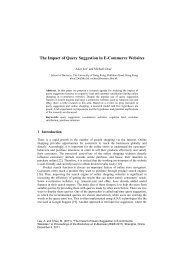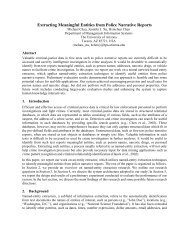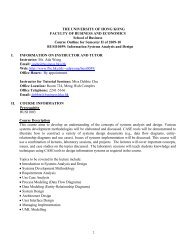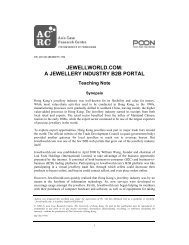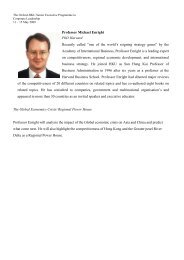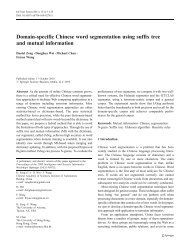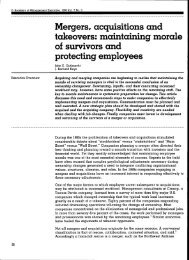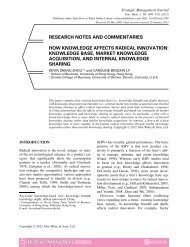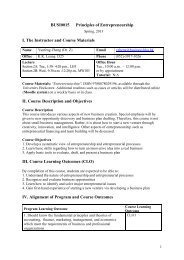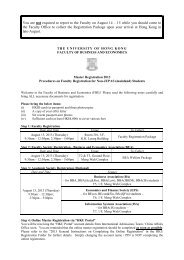Part I Summer 2008 Instructor: Tao LI - Faculty of Business and ...
Part I Summer 2008 Instructor: Tao LI - Faculty of Business and ...
Part I Summer 2008 Instructor: Tao LI - Faculty of Business and ...
- No tags were found...
You also want an ePaper? Increase the reach of your titles
YUMPU automatically turns print PDFs into web optimized ePapers that Google loves.
THE UNIVERSITY OF HONG KONGFACULTY OF BUSINESS AND ECONOMICSMFIN7015 Behavioral Finance: <strong>Part</strong> I<strong>Summer</strong> <strong>2008</strong><strong>Instructor</strong>: <strong>Tao</strong> <strong>LI</strong>N, Ph.D.Email: tlin@hku.hkCOURSE INFORMAITON:Course Overview:Traditional finance, relying on economic agents’ rationality, fails to account for manyempirical facts about the aggregate stock market, the cross-section <strong>of</strong> average returns <strong>and</strong>individual trading behaviors. Behavioral finance proposes psychological explanations <strong>and</strong>introduces less than fully rational agents. In doing so, it helps solve many difficultiesencountered in the traditional finance framework.Course Objective:1. To identify key assumption differences between traditional finance <strong>and</strong> behavioralfinance frameworks.2. To underst<strong>and</strong> key psychological biases that affect decision making process3. To apply psychology research findings into finance anomaliesTextbook:There are no required textbook for this course.Class notes will be distributed in lectures.Selected academic papers will be provided.References:1. Thaler, Richard H. (ed.), 2005, Advances in behavioral finance, Vol. II, New York,Russell Sage Foundation2. Shleifer, Andrei, 2000, Inefficient markets: an introduction to behavioral finance,Oxford University Press3. Kahneman, Daniel, Paul Slovic, <strong>and</strong> Amos Tversky (ed.), 1982, Judgment underuncertainty: Heuristics <strong>and</strong> biases, Cambridge University Press4. Kahneman, Daniel, <strong>and</strong> Amos Tversky (ed.), 2000, Choices, values <strong>and</strong> frames,Cambridge University Press.TEACHING FORMATThe course will be consisted <strong>of</strong> 6 lectures. Your classroom participation is strongly encouraged<strong>and</strong> will be taken into consideration in your performance evaluation. An individual-based projectwill be the basis for the course evaluation.
PROJECTAnalyze a finance related phenomenon using behavioral finance arguments discussed in thiscourse. Document the evidence care fully <strong>and</strong> bring forward your logical explanations. You mayhunt for topics related to hedge fund materials to be discussed in the second half <strong>of</strong> the course.The report is limited to 15 pages (you do not need to write 15 pages if can use 10 pages to finishyour story) excluding references, tables, figures <strong>and</strong> appendix (if any). The specification <strong>of</strong> theformat is as follows: A4 paper, double space with minimum one-inch margin on all sides, a font<strong>of</strong> 12 Times New Roman.The written report in WORD or PDF format is due in my email box (tlin@hku.hk) 6:00pm July7, <strong>2008</strong>. Later report will be accepted with 1% grade penalty for each hour late.COURSE OUT<strong>LI</strong>NE: (Tentative)1 Introductiona) Efficient market hypothesisb) Anomalies – inconsistent with EMHc) Rising <strong>of</strong> behavioral financeSuggested Readings:• Eugene Fama (1998). Market efficiency, long-term returns <strong>and</strong> behavioral finance,Journal <strong>of</strong> Financial Economics 49: 283-307• Eugene Fama (1970). Efficient capital markets: a review <strong>of</strong> theory <strong>and</strong> empirical work,Journal <strong>of</strong> Finance 25: 383-4172 Psychological Foundationa) Non expected utility• Prospect theory• Reference dependence <strong>and</strong> loss aversion• Frame dependence <strong>and</strong> loss aversion• Ambiguity aversionb) Heuristic bias• Representativeness• Availability• Anchoring• Overconfidence• Wishful thinkingSuggested Readings• Amos Tversky <strong>and</strong> Daniel Kahneman (1974). Judgment under uncertainty: heuristics<strong>and</strong> biases, Science 185: 1124-1131
• Daniel Kahneman <strong>and</strong> Amos Tversky (1979). Prospect theory: an analysis <strong>of</strong> decisionunder risk, Econometrica 47: 263-2923 Applications: Stock Returns <strong>and</strong> the Equity Premiuma) Valuation ratios <strong>and</strong> its predicative power on equity returnsb) Equity premium puzzleSuggested Readings• Campbell, John Y., <strong>and</strong> Robert J. Shiller (1996). Valuation ratios <strong>and</strong> long run stockmarket outlook, Journal <strong>of</strong> Portfolio Management 24:1-10• Bernantzi, Shlomo <strong>and</strong> Richard Thaler (1995). Myopic loss aversion <strong>and</strong> the equitypremium puzzle, Quarterly Journal <strong>of</strong> Economics 110: 73-92• Barberis, Nicholas, Ming Huang <strong>and</strong> Tano Santos (2001). Prospect theory <strong>and</strong> assetprices, Quarterly Journal <strong>of</strong> Economics 116: 1-534 Applications: Overreaction <strong>and</strong> Underreactiona) Value vs. growthb) Momentumc) Long-run reversald) Biases in brokerage recommendationsSuggested Readings• Lakonishok, Josef, Andrei Shleifer <strong>and</strong> Robert W. Vishny (1994). Contrarianinvestment, extrapolation, <strong>and</strong> risk, Journal <strong>of</strong> Finance49:1541-78• Jegadeesh, Narasimhan, <strong>and</strong> Sheridan Titman. Momentum, in Thaler R. (ed.), Advancesin Behavioral Finance, New York: Russell Sage Foundation.• Daniel, Kent, David Hirshleifer, <strong>and</strong> Avanidhar Subrahmanyam (1998). Investorpsychology <strong>and</strong> security market under- <strong>and</strong> overreaction, Journal <strong>of</strong> finance 53: 1939-85• De Bondt, Werner F.M., <strong>and</strong> Richard Thaler (1985). Does the stock market overreact?Journal <strong>of</strong> Finance 40: 793-8055 Investor Behaviora) Disposition effectb) Naïve diversificationc) Excessive tradingSuggested Readings• Shefrin, Hersh M., <strong>and</strong> Meir Statman (1985). The disposition to sell winners too early<strong>and</strong> ride losses too long: theory <strong>and</strong> evidence, Journal <strong>of</strong> Finance 40:777-790• Odean, Terrance (1998). Are investors reluctant to realize their losses? Journal <strong>of</strong>Finance 53: 1775-1798• Odean, Terrance (1999). Do investors trade too much? American Economic Review 89:1279-1298
6 Limits to Arbitragea) Noise trader riskb) Efficiency-reducing arbitragec) Short sale constraintsSuggested Readings• Chapter 2, 4, <strong>and</strong> 6 <strong>of</strong> Shleifer (2000)• Froot, Kenneth <strong>and</strong> Emil M. Dabora (1999). How are stock prices affected by thelocation <strong>of</strong> trade? Journal <strong>of</strong> Financial Economics, 53: 189-216• Lamont, Owen A., <strong>and</strong> Richard H. Thaler (2003). Can the market add <strong>and</strong> subtract?Mispricing in tech price care-outs, Journal <strong>of</strong> Political Economy 111: 227-268• Brunnermeier, Markus K., <strong>and</strong> Stefan Nagel (2004). Hedge funds <strong>and</strong> the technologybubble, Journal <strong>of</strong> Finance 59: 2013-2040



